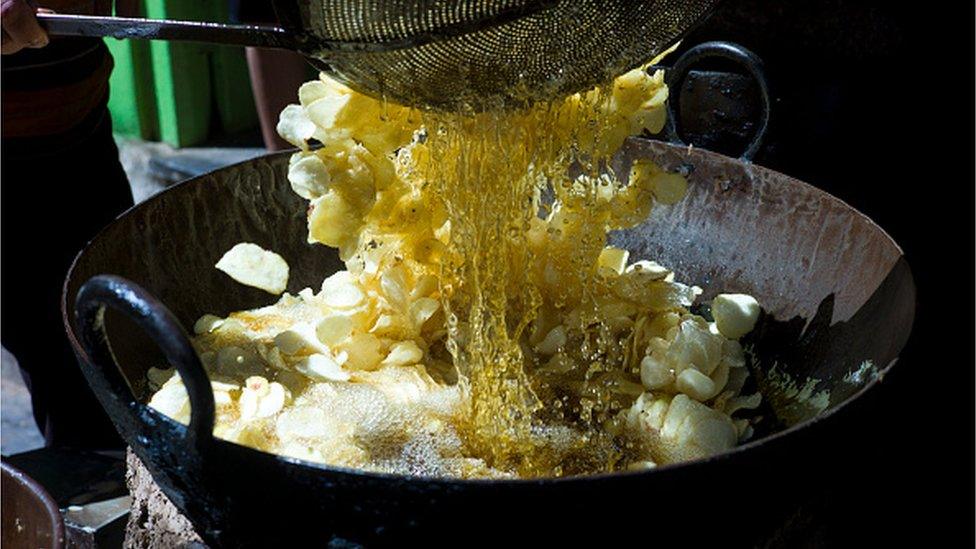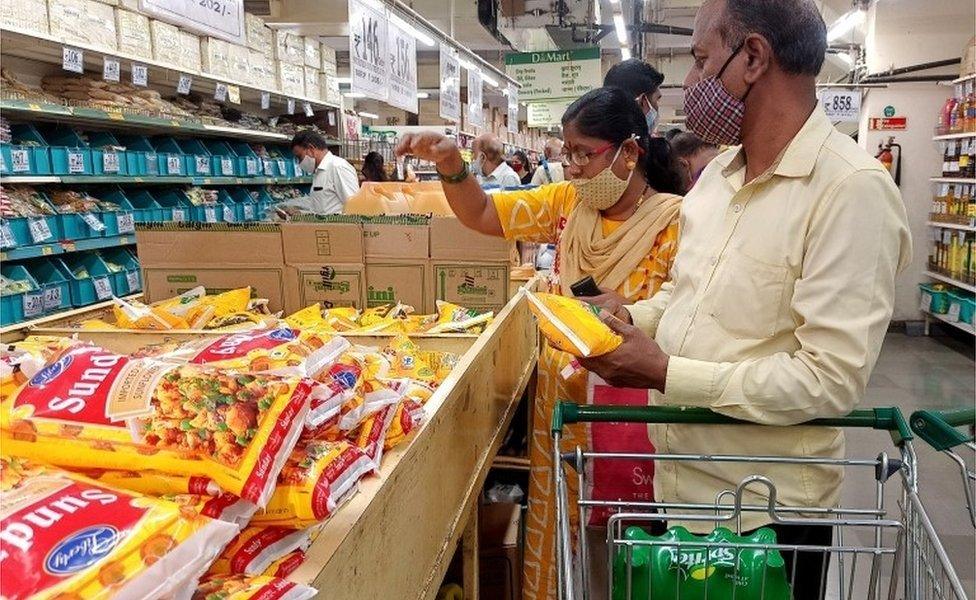Ukraine war: A wake-up call for India - the world's biggest cooking oil importer
- Published

India is the world's second largest consumer and largest importer of cooking oil
Indonesia, the world's biggest producer of palm oil, announced last week that it would halt exports to stabilise spiking prices at home, which it blamed on the war in Ukraine and the pandemic.
Cooking oil is an integral part of the Indian diet. So much so that India is the world's second-largest consumer and largest importer of vegetable oils. Some 56% of its requirements are imported from more than seven countries.
Indians mainly cook with palm, soybean and sunflower oils. For palm oil, the country imports 90% of its requirement from Indonesia and Malaysia. Nearly half of that comes from Indonesia alone.
If this was not enough, half of India's sunflower oil requirements come from Russia and Ukraine, which account for 80% of global exports. The war in Ukraine is likely to lead to a 25% cut in supplies of sunflower oil in the next fiscal year, according to a report. Palm oil inventories in Malaysia, the second-largest producer, are also tight.
This year, India will end up spending about $20bn (£16bn) in importing cooking oil, double of what it spent two years ago. "No country can depend so much on imports. We are bleeding now. This is a big crisis. We need to learn from this war to reduce our dependence on imports," says BV Mehta, executive director of the Solvent Extractors Association, a vegetable oil trade organisation.
India has cut tariffs on cooking oil to calm prices. But rising prices since 2020 and now the disruption in supplies due to the war in Ukraine have made things difficult. There has been a more than 300% rise in two years in global prices of palm oil - the cheapest oil preferred by Indian households, hotels, restaurants and bakeries.

Prices of cooking oil have shot up across the country
Not surprisingly, cooking oil prices have surged more than 20% in less than a month. There have been reports of people stocking up on supplies. Much of the country's fabled cheap street food is deep fried in oil. Along with rice, wheat and salt, cooking oil is a staple for the poorest Indians. "The rise in cooking oil prices is definitely hurting," admits Sudhanshu Pandey, India's senior-most food official.
It also easily fuels food inflation, which hit a 16-month-high of 7.68% in March. Di Yang, a food economist with UN Food and Agricultural Organisation (UNFAO), says that if prices continue to hover around such high levels, India might need to ration supplies as "there is almost no alternative to compensate for import shortages in the short term".
To partially compensate for the shortages, India is pinning its hopes on a good crop of mustard and soybean this year. "Our increased domestic production has meant that India has still not felt the full impact of global inflation as the domestic price rise in cooking oil has been almost half of the global rise in prices," says Mr Pandey. "But in the end, we have to become self reliant and this will happen when farmers will switch to oil seeds when they fetch more attractive prices."
One plan is to grow more oil palm. On the face of it, the idea seems like a good one: it's a highly efficient crop - yielding several times more oil than similar crops like soybean. Palm oil is also highly versatile and can be used in consumer products and industrial applications.

Much of India's palm oil supplies come from Indonesia
But palm is also a water guzzling crop, and new plantations will require slashing down of vast swathes of forests. The government has proposed that a third of the new oil palm plantations can come up in India's hilly-north east. This has predictably raised the hackles of the environmentalists who cite the examples of Indonesia and Malaysia whose success as major palm oil producers has come at the cost of their tropical rainforests.
Mr Pandey says the government plans to treble India's domestic production of palm oil, currently a paltry 2.7%. For the moment, he says, Indians are moving to "cheaper alternatives" of cooking oil.
Traditionally, Indians have cooked with aromatic and strongly flavoured oils like mustard, groundnut, coconut and sesame depending on which part of the country they lived in. The move to foreign vegetable and seed oils like palm and sunflower has possibly something to do with rising urbanisation and cosmopolitanism. These oils are also cheap and makers have sold them as healthier alternatives. "Our cooking oil crisis is partly self-made because of lobbies which have successfully sold imported vegetable oils," says Pritha Sen, a food historian.
Many believe that with more people moving into cities - and migrating within the country - a lot of urban cooking is done with colourless and odourless oils like palm and sunflower to make the food friendly for families and guests with different regional palettes. "Bland and boring have come to define what many Indians cook and eat at home on a regular basis," says Marryam H Reshii, a food writer. "And much of this has to do with the choice of cooking oil."
The rise in prices of these oils is now hurting Indians, who are already facing a cost-of-living squeeze. "Vegetable oils are to Indian cooking what olive oil is to Mediterranean cuisine. The price hike will sharply impact our cooking practices," says Rakesh Raghunathan, a food show host. But then, who knows, this crisis could even nudge people to use cooking oil wisely, wonders Saadia Dhailey, a food writer. After all, a lot of Indians still like very oily food.
